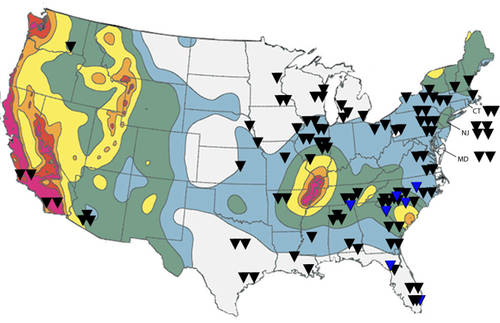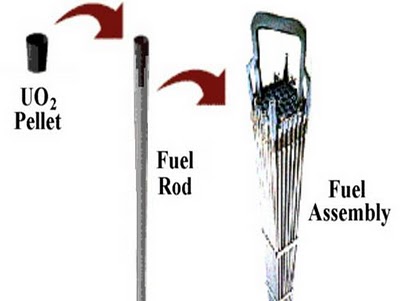.
.
The Intel Hub
By Alex Thomas
March 29th, 2011
Workers at the Fukushima nuclear power plant are working in overdrive, attempting to stop the spread of radioactive materials into the ocean as well as avoid a full scale meltdown.
In a startling development, Crews found traces of plutonium in the soil outside of the Fukushima Dai-ichi nuclear complex on Monday, but officials continued to insist there was no threat to public health. Plutonium is highly dangerous and has raised the level of fear tenfold.
Worried? Apparently at least one person now believes that Plutonium is actually good for human health!
Plutonium, one of the most feared radioactive substances on earth, may in fact enhance human health, according to unexpected new findings published in the journal, Health Physics, wrote Lawrence Solomon in the Financial Post.
Japanese Prime Minister Naoto Kan has stated that Japan is on Maximum Alert and the situation remains unpredictable and ever changing.
Multiple embassies in Japan have started to pass out potassium iodide tablets as a precautionary measure. These tablets are being distributed in a 250km radius yet Japanese officials continue to claim that potassium iodide is only needed within the 20km evacuation zone.
The difference in opinion between the Japanese government and Foreign embassies is so huge that it seems impossible that Japan is not covering up the extent of this disaster.
“The recommendation by the Swedish Radiation Safety Authority that all Swedes who are staying within a radius of 250 km from the Fukushima No. 1 power plant to take iodide tablets every three days is still valid,” the embassy’s website, last updated Saturday, says. “Best protection against radioactive iodine is to take iodide tablets before the exposure, as doing so afterward will prove too late,” reported The Japan Times.
Officials with TEPCO are also facing a major dilemma. They need to cool the reactors with water but at the same time keep the water from contaminating the ocean with toxic radioactive materials.
“TEPCO is in an awful dilemma right now,” said Jim Walsh, an international security expert at the Massachusetts Institute of Technology. “One the one hand, they want to cool the reactor and keep the reactor cool, so they have to pour water in. If there is a leak in one of the containment vessels, that water keeps leaking out. So they have a problem where the more they try to cool it down, the greater the radiation hazard as that water leaks out from the plant,” reported the CNN Wire Staff.
Fox News is reporting that TEPCO officials have LOST the battle to save one of the damaged reactors at the Fukushima nuclear power plant.
“The indications we have, from the reactor to radiation readings and the materials they are seeing, suggest that the core has melted through the bottom of the pressure vessel in unit two, and at least some of it is down on the floor of the drywell,” Lahey told the Guardian.
Meanwhile the Head of TEPCO has all but vanished since a 9.0 earthquake and tsunami devastated Japan on March 11th. He was last seen on the 13th which has led many to speculate that he has left the country.
Amid rumors that Shimizu had fled the country, checked into a hospital or committed suicide, company officials said Monday that their boss had suffered an unspecified “small illness” because of overwork after a 9.0-magnitude earthquake sent a tsunami crashing onto his company’s Fukushima Daiichi nuclear power plant, reported the Washington Post.
There is no way to tell if Shimizu is actually in Tokyo due to the fact that no one has actually seen him.
Officials in the United States have continued to claim that the levels found in the U.S. are no worse then background radiation, ignoring the simple fact that most of these radioactive particles do not normally occur in the atmosphere at all.
Radiation from Japan N-plant reaches Britain
______________________________________________________________________________
Nuclear Crisis In Japan Will Not Slow Relicensing of U.S. Plants
3/29/2011Tom Brakefield/Thinkstock
(WASHINGTON) -- The nuclear crisis at Japan’s Fukushima Daiichi plant will not have an impact on the re-licensing of U.S. nuclear reactors, a top Nuclear Regulatory Commission official told lawmakers Tuesday.
“There’s no technical reason, that I’m aware of, that this would impact the license renewal process for the remaining plants in the U.S.,” Bill Borchardt, the NRC Executive Director for Operations, told the Senate Energy and Natural Resources Committee.
Over half of the 104 operating reactors in the U.S. have already received license renewals for an additional 20 years of operation. The NRC expects that the other half will continue with the license extension process.
“If there was a design change necessary in order to adapt the plants to what we’re learning from Japan we would take that action absent or outside of the license-renewal, review process,” Borchardt explained. “We would take that without hesitation.”
Several lawmakers have called for a moratorium on relicensing in light of the ongoing crisis in Japan.
Peter Lyons, the acting assistant secretary for Nuclear Energy at the Department of Energy, explained that the Fukushima Daiichi plants “are in a slow recovery from the accident. However, long-term cooling of the reactors and pools is essential during this period and has not been adequately restored to date.”
Borchardt agreed. “The situation in general continues to further stabilize, although there are many hurdles that remain.”
Among those hurdles are reports of radioactive water in the basements of the turbine buildings which, according to Borchardt, is from the water that has been injected to cool the reactors.
“We believe that the water is the result of the ‘bleed and feed’ process that they have been using to keep water in the reactor cores and in the containment of the units,” Borchardt said. “The exact flow path of that leakage has not been determined.”
As for reports of plutonium in the soil near the nuclear plant, Lyons said the news did not come as a surprise. “All operating reactors, whether they start with any plutonium in the fuel or not, build up plutonium in the course of operation. So finding plutonium that was derived from either the operating reactors or the spent fuel pools would not be regarded as a major surprise. Certainly it would be a concern if it were in significant levels,” he explained.
________________________________________________________________________
US Radiation Monitoring Map in Real Time (Radiation Network)
_________________________________________________________________________
US Stores Spent Nuclear Fuel Rods At 4 Times Pool Capacity
The Intel HubBy Rady Ananda - Contributing Writer
March 27th, 2011
_________________________________________________________________________
In a recent interview with The Real News Network, Robert Alvarez, a nuclear policy specialist since 1975, reports that spent nuclear fuel in the United States comprises the largest concentration of radioactivity on the planet: 71,000 metric tons. Worse, since the Yucca Mountain waste repository has been scrapped due to its proximity to active faults (see last image), the US Nuclear Regulatory Commission has allowed reactor operators to store four times more waste in the spent fuel pools than they’re designed to handle.
Each Fukushima spent fuel pool holds about 100 metric tons, he says, while each US pool holds from 500-700 metric tons. A single pool fire would release catastrophic amounts of radioactivity, rendering 17-22,000 square miles of area uninhabitable. That’s about the size of New Hampshire and Vermont – from one pool fire.
In a March 25th interview, physician and nuclear activist Dr Helen Caldicott explains that “there’s far more radiation in each of the cooling pools than there is in each reactor itself…. Now the very short-lived isotopes have decayed away to nothing. But the long-lived ones, the very dangerous ones, Cesium, Strontium, Uranium, Plutonium, Americium, Curium, Neptunium, I mean really dangerous ones, the long-lived ones – that’s what the fuel pools hold.”
Nuclear waste, in the form of tiny pellets, are loaded into metal rods, that are then bundled into a “fuel assembly.” The assemblies are stored inside casements that are then submerged in cooling pools that are located at the top of a nuclear reactor, as the following images reveal:
The image at the top of the article shows an entire pool filled with these assemblies. There are millions of these rods around the planet, reports Reuters.
As a Senior Scholar at the Institute for Policy Studies, Alvarez was part of a multidisciplinary international team that looked at possible terror attacks on nuclear facilities, focusing on the spent fuel storage pools. In 2003, they released a report, Reducing the Hazards from Stored Spent Power-Reactor Fuel in the United States, which calls for transferring the spent fuel from the pools into dry-cask storage. (Summary here.)
The report recommends that 75% of the spent rods be removed from each of the pools and stored in ultra-thick concrete bunkers capable of withstanding aerial impact. The project would take about ten years and would “reduce the average inventory of 137Cs (radioactive cesium) in U.S. spent-fuel pools by about a factor of four.”
The NRC attempted to suppress the IPC report, Alvarez says. “The response by the Nuclear Regulatory Commission and nuclear industry was hostile.” But the National Academy of Sciences agreed that a fire in an overloaded fuel pool would be catastrophic. The NRC attempted to block the Academy’s report, as well.
The NRC serves industry, not the public, and by controlling the purse strings, Congress has forced the NRC to “greatly curtail its regulatory programs,” says Alvarez.
Engineer Keith Harmon Snow couldn’t agree more. He recently lambasted the NRC and mainstream media for downplaying the ongoing catastrophe in Japan. He notes that, “The atomic bomb that exploded at Hiroshima created about 2000 curies of radioactivity. The spent fuel pools at Vermont Yankee Nuclear Plant (U.S.) are said to hold about 75 million curies.” [emphasis added]
And that’s just one US nuclear plant, out of 104, not to ignore the undisclosed number of research sites. Then consider that several nuclear plants sit on geologic faults, as this image by Public Integrity reveals:

Also see this global map of earthquake activity and nuclear power plant locations.
Nuclear waste is a serious, deadly and growing problem that the industry refuses to address, preferring to externalize disposal costs onto the public (even suing the US government to clean up its mess for them, under a 1998 law it no doubt favored).
Unless the radioactive waste is laser-launched toward the sun, we’re stuck with waste that will contaminate the biosphere for thousands of years, for the measly prize of 25-30 years of electricity, as nuclear activist and mathematician Gordon Edwards so eloquently explained. The risk far outweighs the benefit; this energy choice exemplifies the insanity of the nuclear industry and its government protectors.
Further Sources:
Chernobyl: Consequences of the Catastrophe for People and the Environment, by Alexey V. Yablokov and Vassily B. Nesterenko and Alexey V. Nesterenko (English publication: 2009), recently reviewed by toxicologist Janette Sherman on BlipTV, and also reviewed last year by Professor Karl Grossman at Global Research.Nuclear Reactors in Earthquake Zones around the Globe (TreeHugger, compiling various sources)
US Radiation Monitoring Map in Real Time (Radiation Network)
Video Maps Spread of Radioactivity in Real Time (Central Institute for Meteorology and Geodynamics, Austria)
Recent articles by Robert Alvarez:
Unsafe at Any Reactor: March 23, 2011
Safeguarding Spent Fuel Pools in the United States: March 21, 2011
The Drained Spent-Fuel Pool at Unit 4: March 16, 2011
__________________________________________________________________________
. .
Donate To Keep This Site Alive
______________________________________________________ ____________________
.
Recommended links:
http://HermannHearsay.blogspot.com/(Hermann Area News, Commentary & Discussion)




































No comments:
Post a Comment